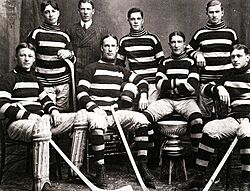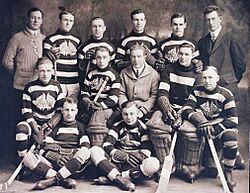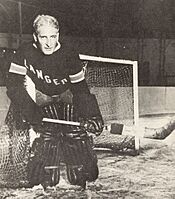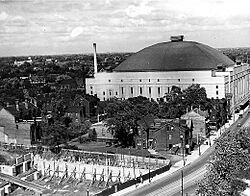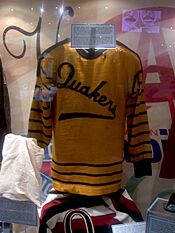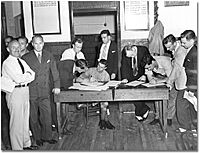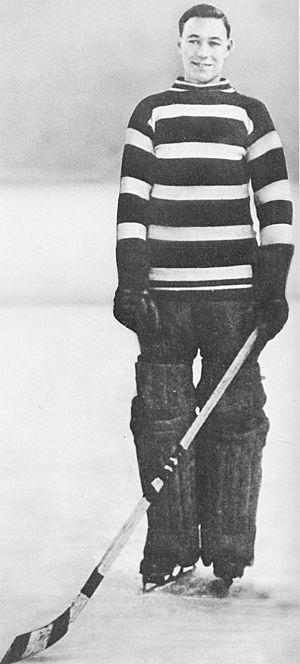History of the National Hockey League (1917–1942) facts for kids
The National Hockey League (NHL) started in 1917. It was formed after its older league, the National Hockey Association (NHA), faced problems. The main reason was a big disagreement with Eddie Livingstone, who owned the Toronto Blueshirts team. Most NHA teams, like the Montreal Canadiens, Montreal Wanderers, and Ottawa Senators, decided to create a new league without him.
At first, the NHL was meant to be a temporary league. But the issues with Livingstone continued, so the new league became permanent. The NHL soon grew, adding teams in the United States, like the Boston Bruins in 1924. By 1926, it was the main hockey league and the only one competing for the famous Stanley Cup.
Hockey rules and equipment also changed a lot during this time. The NHL played with six players per side instead of seven. Goalies were allowed to leave their feet to make saves, which was new! Hockey became even more popular across Canada thanks to Foster Hewitt's radio broadcasts, which started in 1933.
Famous arenas like the Montreal Forum and Maple Leaf Gardens were built. They hosted special All-Star games to help players like Ace Bailey and the family of Howie Morenz, whose careers ended due to on-ice injuries. These early games led to the yearly NHL All-Star games we see today.
The Great Depression and World War II caused the league to shrink. By 1942, only six teams were left: the Boston Bruins, Chicago Black Hawks, Detroit Red Wings, Montreal Canadiens, New York Rangers, and Toronto Maple Leafs. These teams are now known as the "Original Six".
Contents
How Hockey Leagues Began
Competitive ice hockey started getting organized in the late 1800s. Before that, teams mostly played in tournaments. In 1887, several Montreal teams and the Ottawa HC formed the Amateur Hockey Association of Canada (AHAC). They created a regular schedule for games.
Lord Stanley then donated the Stanley Cup. It was given to the best team in the AHAC. This made the league very important and respected.
As hockey became more popular, teams wanted to win even more. They started paying players, which went against the idea of "amateur" sports. This led to new leagues forming, like the Canadian Amateur Hockey League (CAHL) and the Federal Amateur Hockey League (FAHL). In 1904, the International Hockey League (IHL) became the first fully professional league, paying players salaries. This caused a "war" for top players.
By 1905, there were too many teams in some cities, especially Montreal. So, some leagues merged to form the Eastern Canada Amateur Hockey Association (ECAHA). This league allowed both paid and amateur players. Eventually, the ECAHA folded, and new leagues like the Canadian Hockey Association (CHA) and the National Hockey Association (NHA) were created. The NHA had wealthier owners and quickly attracted the best players, leading to the CHA's end in 1910.
Creating the NHL
By the 1916–17 season, the NHA had many problems. The Quebec Bulldogs were struggling financially. Also, the Toronto 228th Battalion team had to leave to fight in World War I.
But the biggest issue was with Toronto Blueshirts owner Eddie Livingstone. Other team owners, like Sam Lichtenhein of the Montreal Wanderers and George Kennedy of the Canadiens, were very frustrated with him. They had been arguing with Livingstone since 1915 over players and other issues.
Because of these problems, the other owners decided to remove the Blueshirts from the NHA in February 1917. They hoped Livingstone would sell his team. But he didn't.
So, in November 1917, the remaining owners realized they couldn't force Livingstone out of the NHA. They decided to suspend the NHA and create a brand new league without him. On November 26, 1917, the National Hockey League was officially formed in Montreal.
The new NHL included the Wanderers, Canadiens, Senators, and Bulldogs. A new team in Toronto, controlled by the Toronto Arena Company, also joined. The NHL used the NHA's rules and named Frank Calder its first president. The Quebec Bulldogs were members but didn't play that first season. Their players were shared among the other teams.
The NHL was supposed to be a temporary solution. The owners hoped to get rid of Livingstone and then return to the NHA later. But Livingstone filed lawsuits against the new league. Despite this, the NHL started playing games just three weeks after it was created.
The first NHL games were played on December 19, 1917. The Montreal Wanderers beat the Toronto Arenas 10–9 in Montreal. This is considered the first NHL game. Dave Ritchie of the Wanderers scored the first goal.
Early Years of the NHL
The NHL's first big star was "Phantom" Joe Malone. He was a great scorer in the NHA. On the NHL's opening night, Malone scored five goals for the Montreal Canadiens. He led the league with 44 goals in 20 games in the 1917–18 season. Later, in 1920, Malone scored an amazing seven goals in one game against the Toronto St. Patricks. This record still stands today! Malone was later put into the Hockey Hall of Fame.
The first goal in NHL history was scored by Dave Ritchie of the Montreal Wanderers. But the Wanderers had bad luck. On January 2, 1918, a fire destroyed the Montreal Arena, which was home to both the Wanderers and the Canadiens. The Canadiens found a new arena, but the Wanderers quit the league because they didn't have enough players due to the war. The NHL continued with only three teams until Quebec rejoined in 1919.
In its early years, the NHL used a "split season" format. The Toronto team won the first NHL championship in 1918. They then beat the Vancouver Millionaires to win the Stanley Cup, becoming the first NHL team to do so.
In 1918–19, the Canadiens won the NHL championship. They went to play the Seattle Metropolitans for the Stanley Cup. But the series was canceled because of the Spanish flu pandemic. Many players got sick, and Canadiens player Joe Hall sadly died from the flu.
The Toronto team struggled in 1918–19. They almost left the league, but they reorganized and became the Toronto St. Patricks. The Quebec team also returned. In 1920, the Quebec team moved to Hamilton, Ontario, and became the Hamilton Tigers.
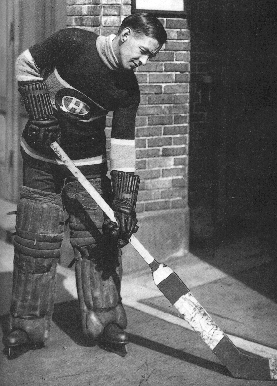
Competing for the Stanley Cup
Starting in 1921, the NHL faced competition from another major league, the Western Canada Hockey League (WCHL). With three leagues trying to get the best players, hockey players earned very high salaries. The WCHL only lasted six seasons. It merged with the Pacific Coast Hockey Association in 1924.
The WCHL challenged the NHL for the Stanley Cup four times. In the 1923 Stanley Cup Finals, the Senators won the Cup. In 1924, the Canadiens won, thanks to great goaltending by Georges Vezina and strong play from rookie Howie Morenz.
In 1924–25, the Hamilton Tigers finished first in the NHL. But their players went on strike, demanding more money for the playoffs. League president Frank Calder suspended the entire team. Montreal was declared the NHL champion after winning their semi-final game.
The Canadiens then played the Victoria Cougars from the WCHL in the 1925 Stanley Cup Finals. Victoria won, becoming the last non-NHL team to win the Stanley Cup. The WCHL stopped playing a year later, and the NHL bought its players. The Tigers' players were bought by Bill Dwyer for his new team, the New York Americans, which started playing in 1925.
NHL Grows in the 1920s
The NHL grew to six teams in 1924. It added a second team in Montreal, the Montreal Maroons, and the first American team, the Boston Bruins. The Bruins were bought by Charles Adams, a grocery store owner. The Maroons were created for Montreal's English-speaking fans. The first NHL game in the United States was played on December 1, 1924, in Boston.
The Montreal Forum, a famous hockey arena, was built in 1924 for the Maroons. The Canadiens moved there two years later. The Forum hosted its first Stanley Cup Finals in 1926, when the Maroons won the Cup.
The New York Americans and Pittsburgh Pirates joined the league in 1925. In 1926–27, three more teams were added. Tex Rickard, who ran Madison Square Garden in New York, saw how popular the Americans were. So, he got his own team, the New York Rangers, in 1926. That same year, Detroit and Chicago also got teams. Detroit bought the players from the Victoria Cougars to create the Detroit Cougars. Chicago bought players for their new Chicago Black Hawks team. These new teams brought the NHL to ten teams!
The Rangers reached the 1928 Stanley Cup Finals in only their second season. Their goalie, Lorne Chabot, got hurt during game two. The Maroons wouldn't let the Rangers use a substitute goalie. So, the Rangers' coach, Lester Patrick, who was 44 years old, had to play goalie himself! Patrick, who used to be a defenceman, only let in one goal. The Rangers won the game in overtime. They then signed another goalie and went on to win the Stanley Cup in five games.
Conn Smythe and the Toronto Maple Leafs
For the NHL's first ten years, Eddie Livingstone kept trying to get his Toronto team back through court. He won some money, but the amount was reduced. The owners of the Toronto St. Patricks, Charlie Querrie and his wife Ida, found it too hard to pay Livingstone. So, they sold the team in 1927.
On February 14, 1927, Conn Smythe bought the St. Patricks for $160,000. One of Smythe's first moves was to rename the team the Toronto Maple Leafs.
Smythe promised the team would win the Stanley Cup within five years. He wanted a star player. In 1930, the Senators were having money problems and put their star defenceman, King Clancy, up for sale. Smythe only had $25,000, half of what Ottawa wanted. To get more money, Smythe entered his racehorse, Rare Jewel, in a big race. Rare Jewel, who was a huge underdog, won the race and earned Smythe over $15,000! Smythe then bought Clancy for $35,000 and two players. This was a huge amount to pay for one player back then. It was also the only race Rare Jewel ever won.
Smythe also dreamed of building a new arena for his team. He wanted a place where people could dress up and be proud to go. He bought land for $350,000. Many people thought he was crazy because the Great Depression was happening. They called his plan "Smythe's Folly." To help pay for it, the Leafs convinced construction workers to accept 20% of their pay in shares of the arena.
Just four and a half months later, Maple Leaf Gardens opened on November 12, 1931. Many of the 13,000 fans wore fancy clothes, just as Smythe had hoped. In 1932, five years after Smythe's promise, the Leafs won the Stanley Cup!
Maple Leaf Gardens also had a special broadcast booth for Foster Hewitt. Hewitt started broadcasting hockey games in 1923. Smythe supported broadcasting Leafs games, even though other owners worried it would hurt ticket sales. By 1931, Hewitt was famous for his catchphrase: "he shoots, he scores!" His broadcasts were heard across Canada and attracted over a million listeners. This was the start of Hockey Night in Canada, a Saturday night tradition that continues today.
The Ace Bailey Benefit Game
On December 13, 1933, a terrible accident happened. Bruins defenceman Eddie Shore hit Toronto's Ace Bailey from behind. Bailey landed on his head and suffered a severe skull fracture. He was so badly hurt that newspapers printed his death notice, but he survived. Bailey never played hockey again. Shore was suspended for 16 games.
To raise money for Bailey's recovery, Maple Leaf Gardens hosted the Ace Bailey All-Star Benefit Game on February 14, 1934. The Maple Leafs played against an all-star team from the rest of the league. They raised over $20,000. Before the game, the Leafs announced that no Toronto player would ever wear Bailey's #6 jersey again. This was the first time in NHL history a team retired a player's jersey number.
Before the game, each player shook Bailey's hand. When Eddie Shore, the player who caused the injury, approached, the crowd became silent. But Bailey extended his hand, and the crowd cheered loudly. It was a very emotional moment.
The Great Depression Years
During the Great Depression, many NHL teams faced money problems. In 1930, the Pittsburgh Pirates moved to Philadelphia and became the Philadelphia Quakers. But they only lasted one season before stopping operations in 1931. The Ottawa Senators also stopped playing for a year but returned in 1932.
The Senators continued to struggle. In 1934, they moved south to become the St. Louis Eagles. But the Eagles only played one year in St. Louis before asking to stop operations. The league bought and closed the team. This meant the NHL would have only eight teams in 1935–36.
The Montreal Canadiens also had financial difficulties. They lost $60,000 over two seasons. There were talks about selling the team and moving it to Cleveland. But a group of Montreal businessmen stepped in and bought the team, keeping it in Montreal.
The Loss of Howie Morenz
The league also lowered its salary cap to $62,500 per team. This meant teams had to trade some of their highly paid star players. The biggest name traded was Montreal's Howie Morenz. He was a three-time Hart Trophy winner and the face of the Canadiens. But with only 2,000 fans coming to games in an arena that held 10,000, the Canadiens traded Morenz to the Black Hawks. Montreal fans were upset and gave Morenz a standing ovation when he scored against the Canadiens. Less than two seasons later, Morenz was traded back to Montreal.
On January 28, 1937, Morenz broke his leg badly during a game. On March 8, he sadly died from a blood clot. Many believed he died of a broken heart because he loved hockey so much and knew he couldn't play again. Fifty thousand people came to his funeral at the Montreal Forum. A benefit game was held for his family, raising $20,000. Morenz was one of the first players chosen for the Hockey Hall of Fame in 1945.
Chicago's "All-American" Team
In the mid-1930s, Chicago Black Hawks owner Frederic McLaughlin wanted a team made only of American players. At the time, very few regular NHL players were American-born. The Black Hawks hired Bill Stewart as the first American coach in NHL history. Their team had eight Americans, including goalie Mike Karakas.
The 1937–38 Black Hawks team only won 14 of 48 games. But in the playoffs, they surprised everyone! They beat the Canadiens and Americans to reach the Stanley Cup Finals against the strong Maple Leafs.
In the first game of the final, the Hawks had to use a minor-league goalie because Karakas was injured. But the Hawks won! Karakas returned for game three, wearing a steel-toed boot, and led the Hawks to win the Stanley Cup. The 1938 Black Hawks are the only team in NHL history to win the Stanley Cup with a losing record in the regular season.
The "Original Six" Era Begins
In the 1942 Stanley Cup Finals, the Maple Leafs were heavily favored. But the Red Wings used a strategy of shooting the puck into the offensive zone and chasing it. The Leafs lost the first three games! However, Toronto made an amazing comeback, winning the next four games and the Stanley Cup. The 1942 Leafs are the only team in NHL history to come back from a 3–0 deficit to win a championship series.
The Montreal Maroons were struggling financially and couldn't compete with the Canadiens for fans. They stopped playing before the 1938–39 season. The New York Americans were also having money problems. By 1942, 90 players had left the NHL to fight in World War II. Because of financial issues and a lack of players, the Americans stopped playing before the 1942–43 season. This is how the "Original Six" era of the National Hockey League began, with only six teams left.
Rules and New Ideas
The 1920s brought many new rules as hockey changed. The Ottawa Senators won three Stanley Cups in the early 1920s with strong defence and great goaltending from Clint Benedict. He set a record with 22 shutouts in 44 games in 1921. The Senators used a strategy where they kept defencemen and a forward in their own zone after getting a lead. After their third championship in 1924, Frank Calder made a rule against having more than two players in their defensive zone if the puck wasn't there.
Defence was still very strong. In 1928–29, teams scored less than three goals per game on average. Canadiens goalie George Hainsworth set a league record with 22 shutouts in just 44 games! So, in 1929, the league allowed the forward pass in all zones. Before, it was only allowed in certain areas. This change made scoring go up. But players started waiting right in front of the opponent's net. So, the league quickly added the offside rule, which stops offensive players from entering the opponent's zone before the puck. Even with this, players like Cooney Weiland, Dit Clapper, and Howie Morenz scored over 40 goals.
Boston Bruins owner Charles Adams didn't like it when teams shot the puck all the way down the ice (icing) to relieve pressure. After a game where the New York Americans iced the puck 61 times, Adams promised his team would do the same. The Bruins iced the puck 87 times in a game! So, the NHL added the icing rule the next season. Now, if a team ices the puck, the play stops, and the faceoff happens in their defensive zone.
Clint Benedict became the first goalie to wear face protection during a game. He wore a leather mask in 1930 to protect a broken nose. But the mask made it hard to see, so he stopped using it. Later, he was hit by a puck again, which ended his career.
When the NHL started, they changed a rule that used to fine goalies for leaving their feet to make a save. Frank Calder said goalies could "stand on their head if they choose to." This phrase is still used today to describe a goalie who plays an amazing game.
Art Ross was another person who brought new ideas to the game. He designed rounded goal nets that became the standard for the league. He also pushed for using synthetic rubber pucks instead of real rubber. Some of his ideas didn't catch on, like a puck with rounded edges or a two-piece hockey stick with a metal shaft. But his stick idea was a very early version of the modern composite sticks used today.
Timeline
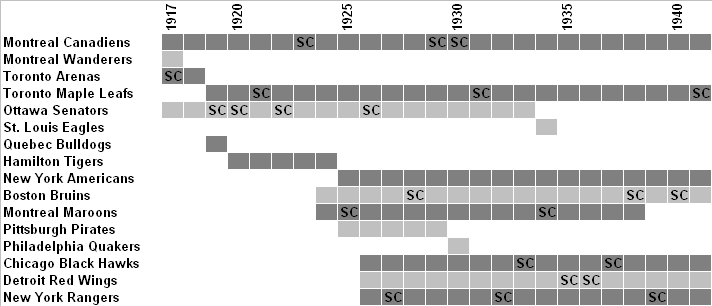
Notes
- Toronto Maple Leafs known as the St. Patricks 1919–1927
- Detroit Red Wings known as the Cougars 1926–1930 and Falcons 1930–1932
- New York Americans known as the Brooklyn Americans 1941–1942
- "SC" denotes won Stanley Cup
See also


